MERCEDES-BENZ SPRINTER 2005 Service Repair Manual
Manufacturer: MERCEDES-BENZ, Model Year: 2005, Model line: SPRINTER, Model: MERCEDES-BENZ SPRINTER 2005Pages: 1232, PDF Size: 39.23 MB
Page 231 of 1232

INSTALLATION
(1) Position the time delay relay to its vehicle wire
harness connector within the driver side seat riser.
(2) Align the time delay relay terminals with the
terminal cavities in the vehicle wire harness connec-
tor.
(3) Push firmly and evenly on the top of the time
delay relay until the terminals are fully seated in the
terminal cavities in the vehicle wire harness connec-
tor.(4) Position the cover panel onto the top of the
driver side seat riser (Fig. 12).
(5) Install and tighten the two screws that secure
the cover panel to the top of the seat riser under the
driver side front seat. Tighten the screws to 2 N´m
(18 in. lbs.).
(6) Move the driver side front seat back to its driv-
ing position.
(7) Reconnect the battery negative cable.
VALAMPS/LIGHTING - INTERIOR 8L - 33
TIME DELAY RELAY (Continued)
Page 232 of 1232

Page 233 of 1232
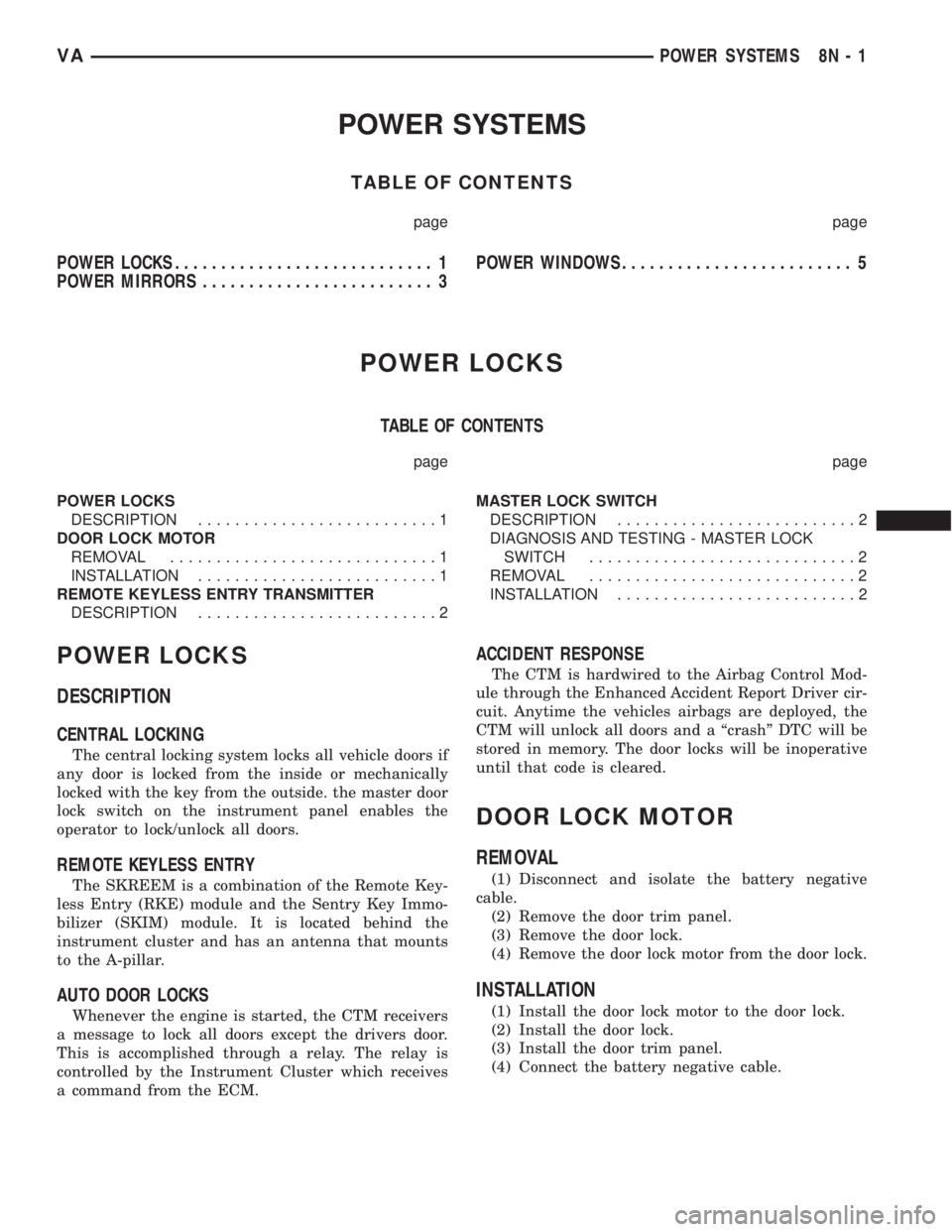
POWER SYSTEMS
TABLE OF CONTENTS
page page
POWER LOCKS............................ 1
POWER MIRRORS......................... 3POWER WINDOWS......................... 5
POWER LOCKS
TABLE OF CONTENTS
page page
POWER LOCKS
DESCRIPTION..........................1
DOOR LOCK MOTOR
REMOVAL.............................1
INSTALLATION..........................1
REMOTE KEYLESS ENTRY TRANSMITTER
DESCRIPTION..........................2MASTER LOCK SWITCH
DESCRIPTION..........................2
DIAGNOSIS AND TESTING - MASTER LOCK
SWITCH.............................2
REMOVAL.............................2
INSTALLATION..........................2
POWER LOCKS
DESCRIPTION
CENTRAL LOCKING
The central locking system locks all vehicle doors if
any door is locked from the inside or mechanically
locked with the key from the outside. the master door
lock switch on the instrument panel enables the
operator to lock/unlock all doors.
REMOTE KEYLESS ENTRY
The SKREEM is a combination of the Remote Key-
less Entry (RKE) module and the Sentry Key Immo-
bilizer (SKIM) module. It is located behind the
instrument cluster and has an antenna that mounts
to the A-pillar.
AUTO DOOR LOCKS
Whenever the engine is started, the CTM receivers
a message to lock all doors except the drivers door.
This is accomplished through a relay. The relay is
controlled by the Instrument Cluster which receives
a command from the ECM.
ACCIDENT RESPONSE
The CTM is hardwired to the Airbag Control Mod-
ule through the Enhanced Accident Report Driver cir-
cuit. Anytime the vehicles airbags are deployed, the
CTM will unlock all doors and a ªcrashº DTC will be
stored in memory. The door locks will be inoperative
until that code is cleared.
DOOR LOCK MOTOR
REMOVAL
(1) Disconnect and isolate the battery negative
cable.
(2) Remove the door trim panel.
(3) Remove the door lock.
(4) Remove the door lock motor from the door lock.
INSTALLATION
(1) Install the door lock motor to the door lock.
(2) Install the door lock.
(3) Install the door trim panel.
(4) Connect the battery negative cable.
VAPOWER SYSTEMS 8N - 1
Page 234 of 1232
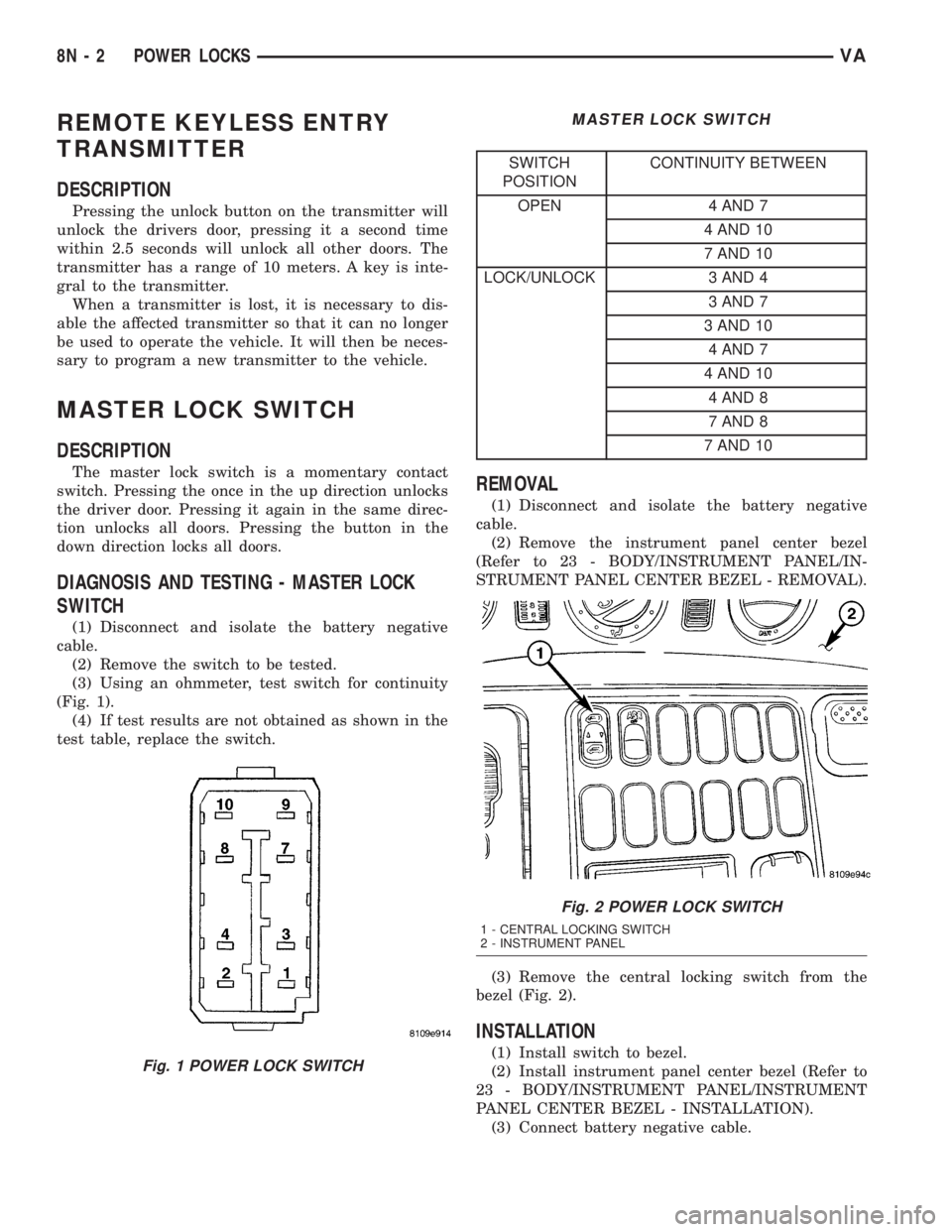
REMOTE KEYLESS ENTRY
TRANSMITTER
DESCRIPTION
Pressing the unlock button on the transmitter will
unlock the drivers door, pressing it a second time
within 2.5 seconds will unlock all other doors. The
transmitter has a range of 10 meters. A key is inte-
gral to the transmitter.
When a transmitter is lost, it is necessary to dis-
able the affected transmitter so that it can no longer
be used to operate the vehicle. It will then be neces-
sary to program a new transmitter to the vehicle.
MASTER LOCK SWITCH
DESCRIPTION
The master lock switch is a momentary contact
switch. Pressing the once in the up direction unlocks
the driver door. Pressing it again in the same direc-
tion unlocks all doors. Pressing the button in the
down direction locks all doors.
DIAGNOSIS AND TESTING - MASTER LOCK
SWITCH
(1) Disconnect and isolate the battery negative
cable.
(2) Remove the switch to be tested.
(3) Using an ohmmeter, test switch for continuity
(Fig. 1).
(4) If test results are not obtained as shown in the
test table, replace the switch.
MASTER LOCK SWITCH
SWITCH
POSITIONCONTINUITY BETWEEN
OPEN 4 AND 7
4 AND 10
7 AND 10
LOCK/UNLOCK 3 AND 4
3 AND 7
3 AND 10
4 AND 7
4 AND 10
4 AND 8
7 AND 8
7 AND 10
REMOVAL
(1) Disconnect and isolate the battery negative
cable.
(2) Remove the instrument panel center bezel
(Refer to 23 - BODY/INSTRUMENT PANEL/IN-
STRUMENT PANEL CENTER BEZEL - REMOVAL).
(3) Remove the central locking switch from the
bezel (Fig. 2).
INSTALLATION
(1) Install switch to bezel.
(2) Install instrument panel center bezel (Refer to
23 - BODY/INSTRUMENT PANEL/INSTRUMENT
PANEL CENTER BEZEL - INSTALLATION).
(3) Connect battery negative cable.Fig. 1 POWER LOCK SWITCH
Fig. 2 POWER LOCK SWITCH
1 - CENTRAL LOCKING SWITCH
2 - INSTRUMENT PANEL
8N - 2 POWER LOCKSVA
Page 235 of 1232
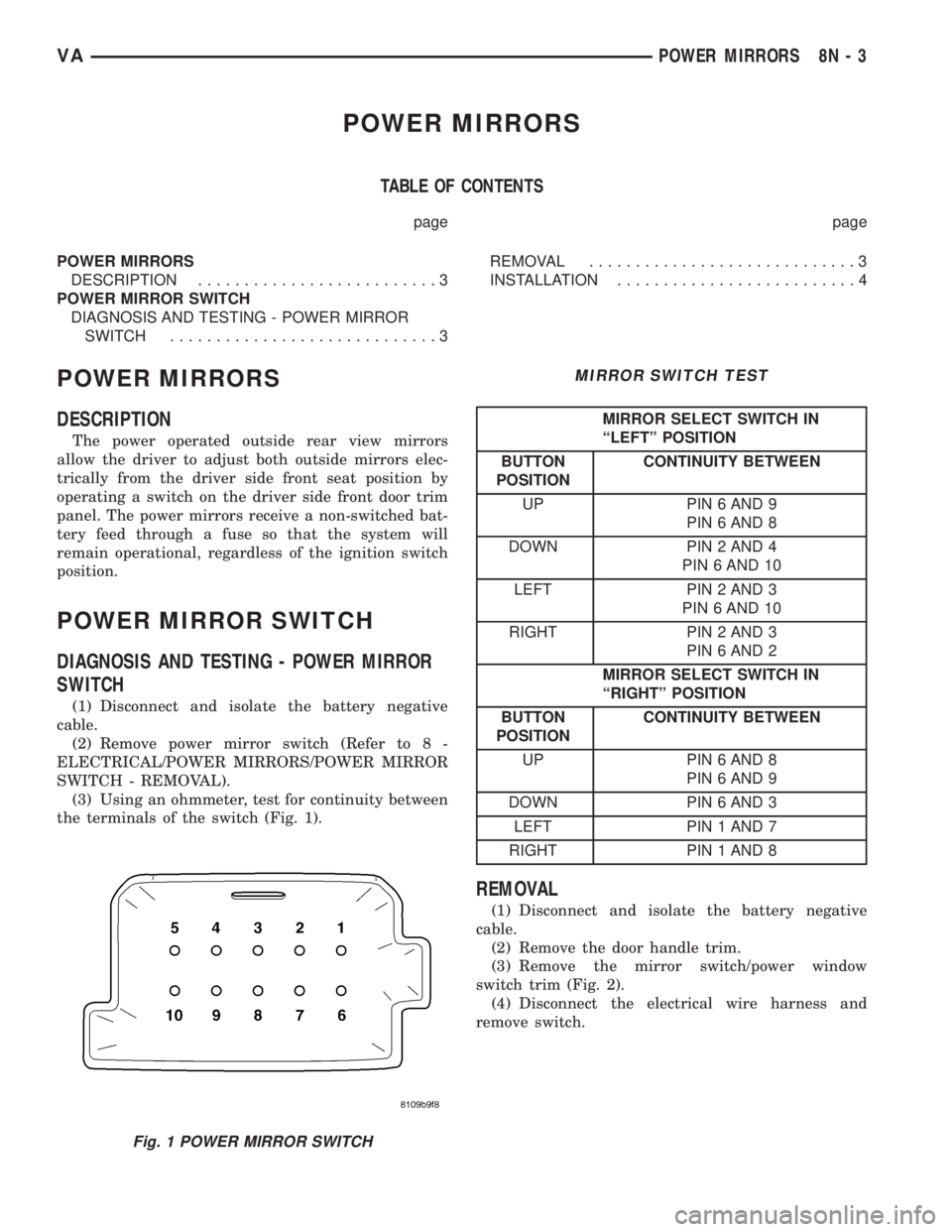
POWER MIRRORS
TABLE OF CONTENTS
page page
POWER MIRRORS
DESCRIPTION..........................3
POWER MIRROR SWITCH
DIAGNOSIS AND TESTING - POWER MIRROR
SWITCH.............................3REMOVAL.............................3
INSTALLATION..........................4
POWER MIRRORS
DESCRIPTION
The power operated outside rear view mirrors
allow the driver to adjust both outside mirrors elec-
trically from the driver side front seat position by
operating a switch on the driver side front door trim
panel. The power mirrors receive a non-switched bat-
tery feed through a fuse so that the system will
remain operational, regardless of the ignition switch
position.
POWER MIRROR SWITCH
DIAGNOSIS AND TESTING - POWER MIRROR
SWITCH
(1) Disconnect and isolate the battery negative
cable.
(2) Remove power mirror switch (Refer to 8 -
ELECTRICAL/POWER MIRRORS/POWER MIRROR
SWITCH - REMOVAL).
(3) Using an ohmmeter, test for continuity between
the terminals of the switch (Fig. 1).
MIRROR SWITCH TEST
MIRROR SELECT SWITCH IN
ªLEFTº POSITION
BUTTON
POSITIONCONTINUITY BETWEEN
UP PIN 6 AND 9
PIN 6 AND 8
DOWN PIN 2 AND 4
PIN 6 AND 10
LEFT PIN 2 AND 3
PIN 6 AND 10
RIGHT PIN 2 AND 3
PIN 6 AND 2
MIRROR SELECT SWITCH IN
ªRIGHTº POSITION
BUTTON
POSITIONCONTINUITY BETWEEN
UP PIN 6 AND 8
PIN 6 AND 9
DOWN PIN 6 AND 3
LEFT PIN 1 AND 7
RIGHT PIN 1 AND 8
REMOVAL
(1) Disconnect and isolate the battery negative
cable.
(2) Remove the door handle trim.
(3) Remove the mirror switch/power window
switch trim (Fig. 2).
(4) Disconnect the electrical wire harness and
remove switch.
Fig. 1 POWER MIRROR SWITCH
VAPOWER MIRRORS 8N - 3
Page 236 of 1232
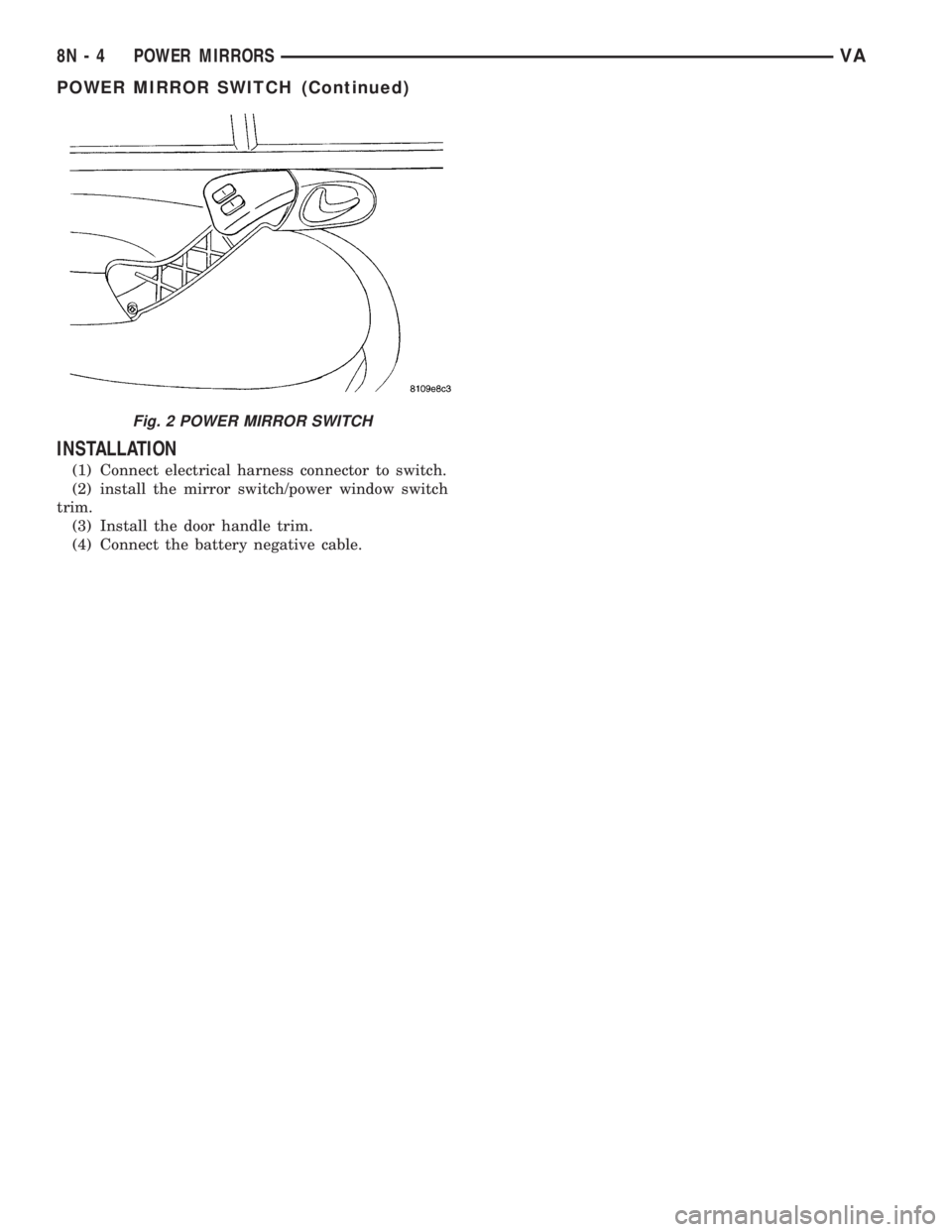
INSTALLATION
(1) Connect electrical harness connector to switch.
(2) install the mirror switch/power window switch
trim.
(3) Install the door handle trim.
(4) Connect the battery negative cable.
Fig. 2 POWER MIRROR SWITCH
8N - 4 POWER MIRRORSVA
POWER MIRROR SWITCH (Continued)
Page 237 of 1232
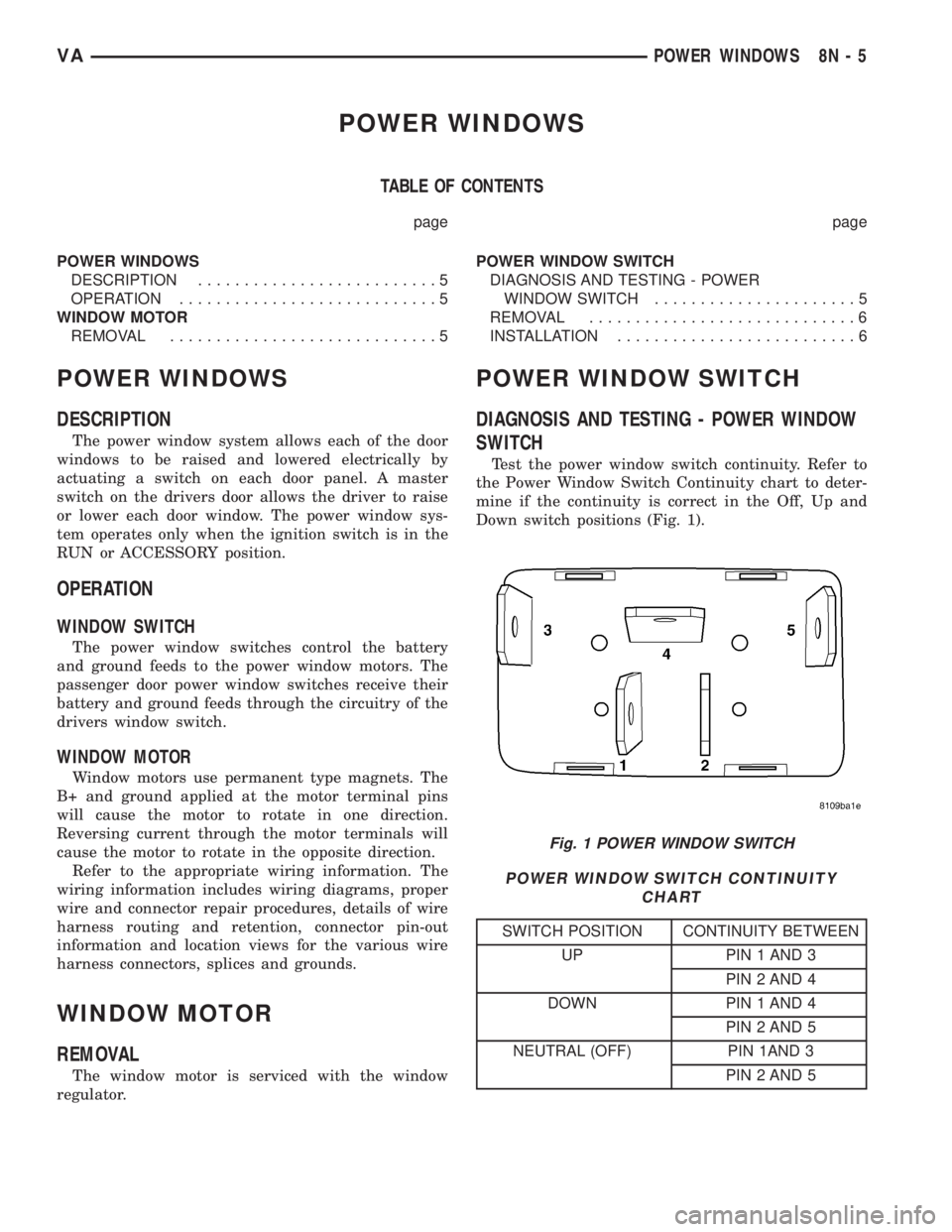
POWER WINDOWS
TABLE OF CONTENTS
page page
POWER WINDOWS
DESCRIPTION..........................5
OPERATION............................5
WINDOW MOTOR
REMOVAL.............................5POWER WINDOW SWITCH
DIAGNOSIS AND TESTING - POWER
WINDOW SWITCH......................5
REMOVAL.............................6
INSTALLATION..........................6
POWER WINDOWS
DESCRIPTION
The power window system allows each of the door
windows to be raised and lowered electrically by
actuating a switch on each door panel. A master
switch on the drivers door allows the driver to raise
or lower each door window. The power window sys-
tem operates only when the ignition switch is in the
RUN or ACCESSORY position.
OPERATION
WINDOW SWITCH
The power window switches control the battery
and ground feeds to the power window motors. The
passenger door power window switches receive their
battery and ground feeds through the circuitry of the
drivers window switch.
WINDOW MOTOR
Window motors use permanent type magnets. The
B+ and ground applied at the motor terminal pins
will cause the motor to rotate in one direction.
Reversing current through the motor terminals will
cause the motor to rotate in the opposite direction.
Refer to the appropriate wiring information. The
wiring information includes wiring diagrams, proper
wire and connector repair procedures, details of wire
harness routing and retention, connector pin-out
information and location views for the various wire
harness connectors, splices and grounds.
WINDOW MOTOR
REMOVAL
The window motor is serviced with the window
regulator.
POWER WINDOW SWITCH
DIAGNOSIS AND TESTING - POWER WINDOW
SWITCH
Test the power window switch continuity. Refer to
the Power Window Switch Continuity chart to deter-
mine if the continuity is correct in the Off, Up and
Down switch positions (Fig. 1).
POWER WINDOW SWITCH CONTINUITY
CHART
SWITCH POSITION CONTINUITY BETWEEN
UP PIN 1 AND 3
PIN 2 AND 4
DOWN PIN 1 AND 4
PIN 2 AND 5
NEUTRAL (OFF) PIN 1AND 3
PIN 2 AND 5
Fig. 1 POWER WINDOW SWITCH
VAPOWER WINDOWS 8N - 5
Page 238 of 1232
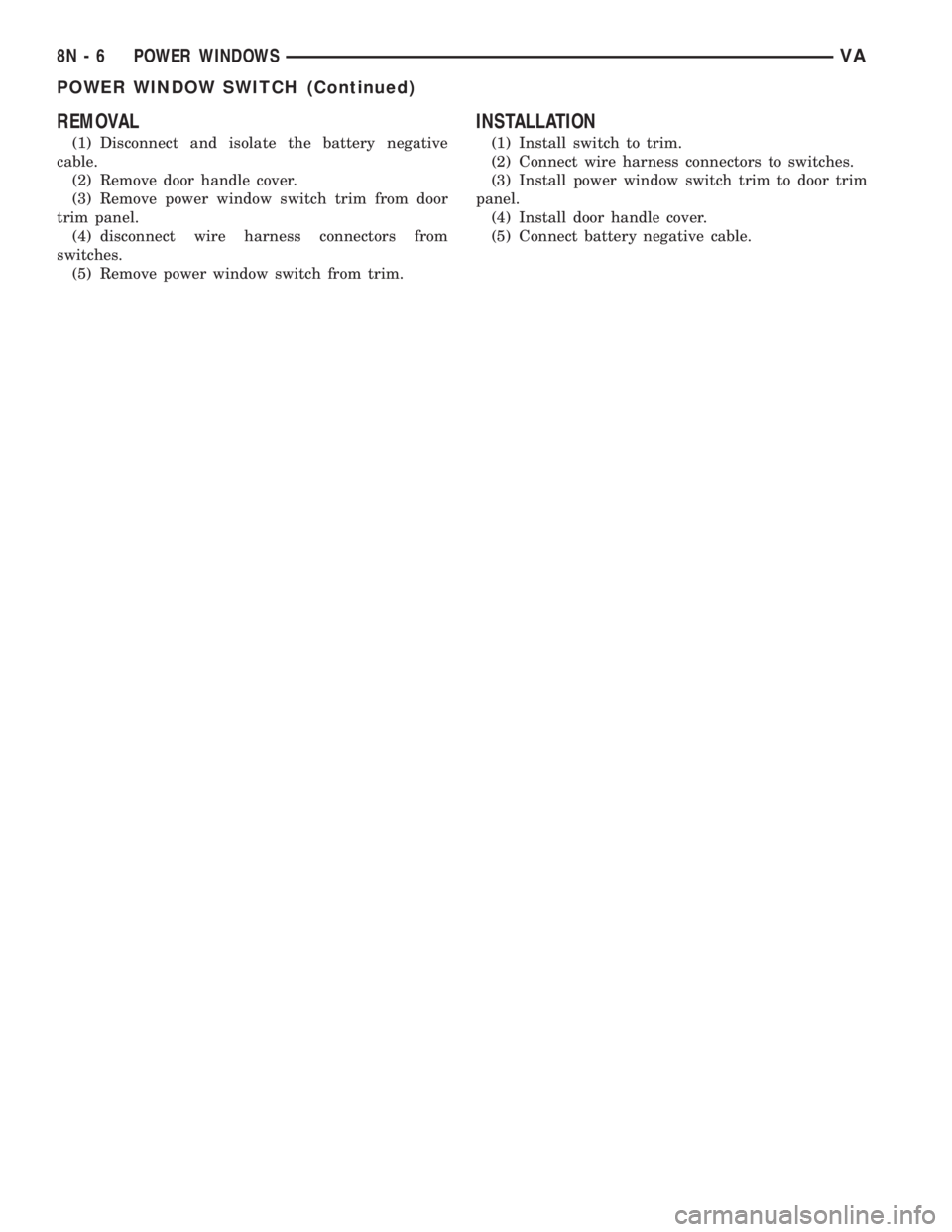
REMOVAL
(1) Disconnect and isolate the battery negative
cable.
(2) Remove door handle cover.
(3) Remove power window switch trim from door
trim panel.
(4) disconnect wire harness connectors from
switches.
(5) Remove power window switch from trim.
INSTALLATION
(1) Install switch to trim.
(2) Connect wire harness connectors to switches.
(3) Install power window switch trim to door trim
panel.
(4) Install door handle cover.
(5) Connect battery negative cable.
8N - 6 POWER WINDOWSVA
POWER WINDOW SWITCH (Continued)
Page 239 of 1232
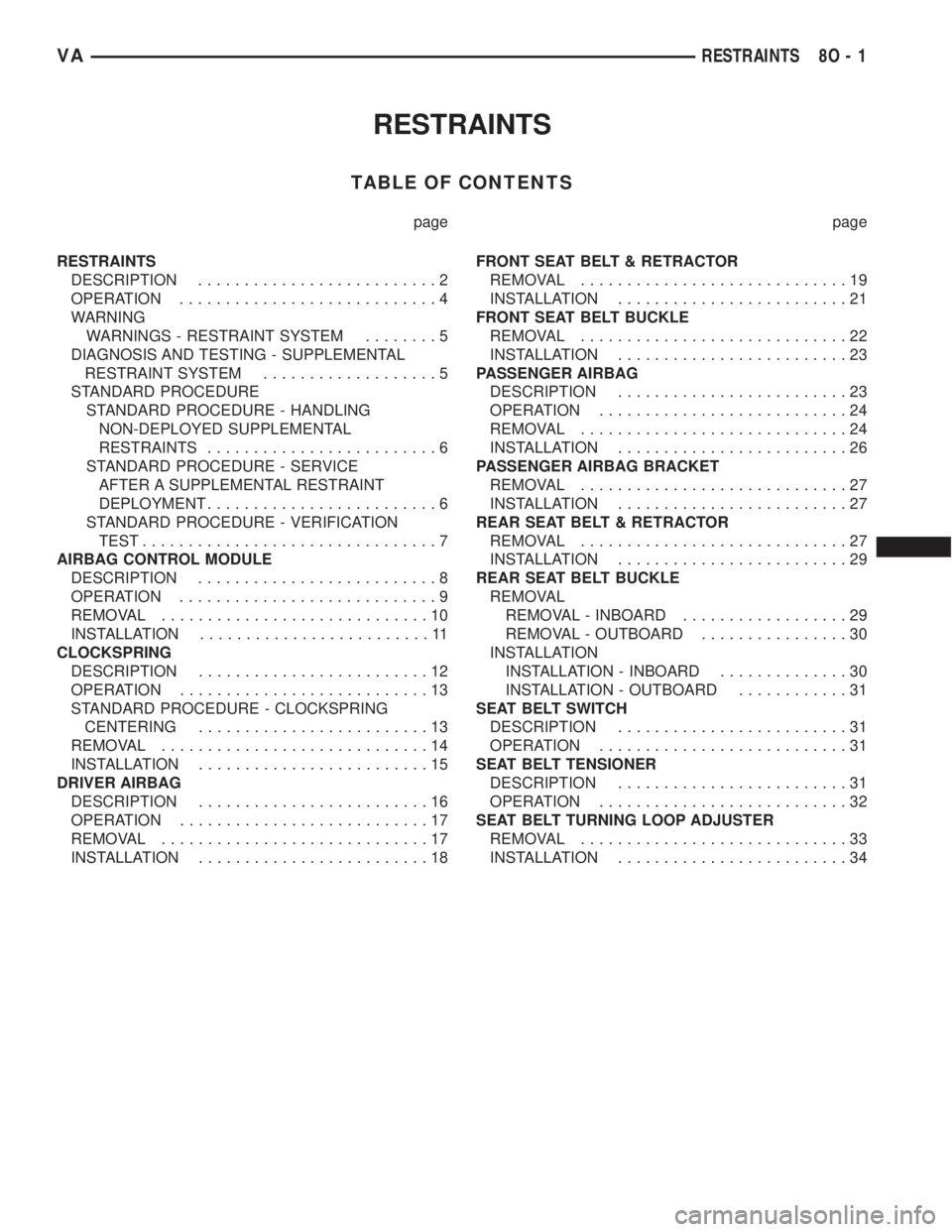
RESTRAINTS
TABLE OF CONTENTS
page page
RESTRAINTS
DESCRIPTION..........................2
OPERATION............................4
WARNING
WARNINGS - RESTRAINT SYSTEM........5
DIAGNOSIS AND TESTING - SUPPLEMENTAL
RESTRAINT SYSTEM...................5
STANDARD PROCEDURE
STANDARD PROCEDURE - HANDLING
NON-DEPLOYED SUPPLEMENTAL
RESTRAINTS.........................6
STANDARD PROCEDURE - SERVICE
AFTER A SUPPLEMENTAL RESTRAINT
DEPLOYMENT.........................6
STANDARD PROCEDURE - VERIFICATION
TEST................................7
AIRBAG CONTROL MODULE
DESCRIPTION..........................8
OPERATION............................9
REMOVAL.............................10
INSTALLATION.........................11
CLOCKSPRING
DESCRIPTION.........................12
OPERATION...........................13
STANDARD PROCEDURE - CLOCKSPRING
CENTERING.........................13
REMOVAL.............................14
INSTALLATION.........................15
DRIVER AIRBAG
DESCRIPTION.........................16
OPERATION...........................17
REMOVAL.............................17
INSTALLATION.........................18FRONT SEAT BELT & RETRACTOR
REMOVAL.............................19
INSTALLATION.........................21
FRONT SEAT BELT BUCKLE
REMOVAL.............................22
INSTALLATION.........................23
PASSENGER AIRBAG
DESCRIPTION.........................23
OPERATION...........................24
REMOVAL.............................24
INSTALLATION.........................26
PASSENGER AIRBAG BRACKET
REMOVAL.............................27
INSTALLATION.........................27
REAR SEAT BELT & RETRACTOR
REMOVAL.............................27
INSTALLATION.........................29
REAR SEAT BELT BUCKLE
REMOVAL
REMOVAL - INBOARD..................29
REMOVAL - OUTBOARD................30
INSTALLATION
INSTALLATION - INBOARD..............30
INSTALLATION - OUTBOARD............31
SEAT BELT SWITCH
DESCRIPTION.........................31
OPERATION...........................31
SEAT BELT TENSIONER
DESCRIPTION.........................31
OPERATION...........................32
SEAT BELT TURNING LOOP ADJUSTER
REMOVAL.............................33
INSTALLATION.........................34
VARESTRAINTS 8O - 1
Page 240 of 1232
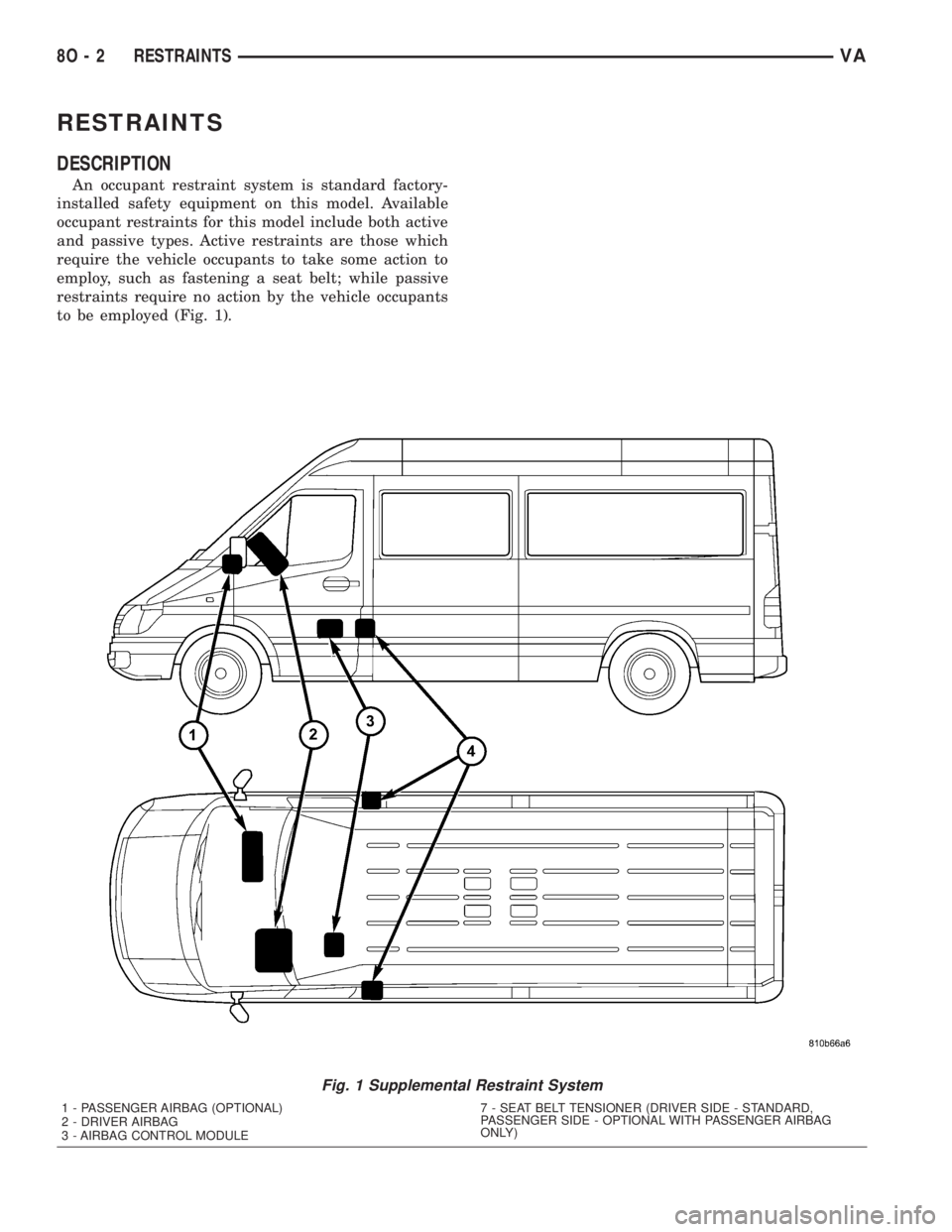
RESTRAINTS
DESCRIPTION
An occupant restraint system is standard factory-
installed safety equipment on this model. Available
occupant restraints for this model include both active
and passive types. Active restraints are those which
require the vehicle occupants to take some action to
employ, such as fastening a seat belt; while passive
restraints require no action by the vehicle occupants
to be employed (Fig. 1).
Fig. 1 Supplemental Restraint System
1 - PASSENGER AIRBAG (OPTIONAL)
2 - DRIVER AIRBAG
3 - AIRBAG CONTROL MODULE7 - SEAT BELT TENSIONER (DRIVER SIDE - STANDARD,
PASSENGER SIDE - OPTIONAL WITH PASSENGER AIRBAG
ONLY)
8O - 2 RESTRAINTSVA